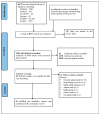A Systematic Review of Joint Spatial and Spatiotemporal Models in Health Research
- PMID: 37047911
- PMCID: PMC10094468
- DOI: 10.3390/ijerph20075295
A Systematic Review of Joint Spatial and Spatiotemporal Models in Health Research
Abstract
With the advancement of spatial analysis approaches, methodological research addressing the technical and statistical issues related to joint spatial and spatiotemporal models has increased. Despite the benefits of spatial modelling of several interrelated outcomes simultaneously, there has been no published systematic review on this topic, specifically when such models would be useful. This systematic review therefore aimed at reviewing health research published using joint spatial and spatiotemporal models. A systematic search of published studies that applied joint spatial and spatiotemporal models was performed using six electronic databases without geographic restriction. A search with the developed search terms yielded 4077 studies, from which 43 studies were included for the systematic review, including 15 studies focused on infectious diseases and 11 on cancer. Most of the studies (81.40%) were performed based on the Bayesian framework. Different joint spatial and spatiotemporal models were applied based on the nature of the data, population size, the incidence of outcomes, and assumptions. This review found that when the outcome is rare or the population is small, joint spatial and spatiotemporal models provide better performance by borrowing strength from related health outcomes which have a higher prevalence. A framework for the design, analysis, and reporting of such studies is also needed.
Keywords: disease mapping; geographic information system; joint spatiotemporal analysis; public health; shared component models; spatial analysis; systematic review.
Conflict of interest statement
The authors have no conflict of interest with this paper.
Figures
References
-
- Sui D.Z. Tobler’s first law of geography: A big idea for a small world? Ann. Assoc. Am. Geogr. 2004;94:269–277. doi: 10.1111/j.1467-8306.2004.09402003.x. - DOI
-
- Leitner M., Glasner P., Kounadi O. Oxford Research Encyclopedia of Criminology and Criminal Justice. Oxford University Press; New York, NY, USA: 2018. Laws of geography.
Publication types
MeSH terms
LinkOut - more resources
Full Text Sources




